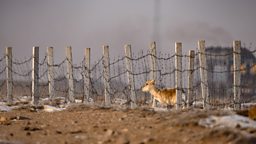Gazelle migration: stopped by the tracks
By Sam Rowley, Assistant Producer

Imagine the Serengeti’s famous ‘great migration’, but replace the tropical savannah with a freezing dustbowl, and substitute wildebeest for cute little gazelles – and crocodiles for trains. That’s the scenario I set out to film in Mongolia, for the Arid Heart episode of the Asia series.
Whilst it’s a romantic image, the gazelles’ lifestyle poses quite the challenge for filmmakers.
Unlike the mass migrations of East Africa, the Mongolian gazelles’ wanderings are seemingly random and chaotic. They are true nomads, chasing the rains, and the promise of distant feeding grounds. Whilst it’s a romantic image, the gazelles’ lifestyle poses quite the challenge for filmmakers.
Scientists estimate that there are between half a million and two million gazelles in Mongolia. Yet this is a vast country, six times the size of the UK. So, despite these staggering numbers, you could travel for hundreds of miles without seeing a single gazelle. Tantalizing stories of mega-herds of up to two hundred thousand individuals have been reported, but we were warned that there was a reasonable chance that we might see just a handful on our shoot. We knew we would have to rely on luck when we travelled to the frozen steppe.

Our drive to the filming location ran parallel to the Trans-Siberian Railway, a major trade route that passes through Mongolia. Speaking to local biologists and rangers, we were told that, strangely, this railway is the most reliable place in the country to see gazelles. Often travelling up to a hundred and fifty kilometres a day, the migrants are confronted with a barbed-wire fence either side of the train tracks. The fence is designed to keep livestock away, but it also obstructs the gazelles, causing thousands to aggregate as they desperately search for a way through. Tempting swathes of un-grazed grass grows around the train tracks, so, if the gazelles do manage to find a gap, they are then reluctant to leave. This unusual situation would provide us with our best opportunity to see and film the animals.
Arriving at our destination, the effects of the railway on the gazelles quickly became apparent.
As we drove along the road, we started to glimpse the odd gazelle, gleefully munching away unperturbed by the temperature (minus forty degrees Celsius) and blizzards. Opening the window for a better view, we were hit by a blast of truly freezing air, and it sunk in that these were the conditions we would be working in for the next five weeks. As is often the case on such shoots, local people held the key to surviving, having been solving these problems for millennia. The glamping yurts you’ll find at music festivals have forever been popular in Central Asia for a reason – they’re some of the cosiest, most luxurious, yet mobile, accommodation you can find. In Mongolia, they’re known as gers,and they would become a lifeline for the team.
Arriving at our destination, the effects of the railway on the gazelles quickly became apparent. We were delighted to see hundreds of them on either side of the tracks, but, with every passing kilometre, we would see more and more of their carcasses caught in the barbed wire, their presence highlighted by black vultures circling overhead. The cause of the fatalities quickly became all too apparent: as a train came thundering past, the gazelles scattered and in their panic, many snagged a limb in the barbed fencing before quickly succumbing to blood loss and shock.

The wilds of Mongolia are mainly composed of gently undulating steppe, occasionally punctuated by rivers or groves of trees. Mongolia’s wildlife, which has evolved in a land of unbroken horizons, has previously never had to tackle the likes of roads and train tracks, and are unaware of the dangers that they present. Migrations of khulan, a type of ass, have been severely impacted by the railway (and major roads) with consequential catastrophic impacts on their population. If nothing is done, Mongolian gazelles could well suffer the same fate.
As the weeks passed by, gazelle deaths sadly became part of our daily routine.
As the weeks passed by, gazelle deaths sadly became part of our daily routine. Although, unknown to us, new terrors lay ahead. We began to notice an enormous feral dog prowling the tracks. Dogs are used by local herders to protect their animals from wild predators, but many escape and are forming a feral population. With the gazelles trapped by the fences around the railway, the dogs have learned that they are easy prey. One dog, which we filmed for Arid Heart, would chase the gazelles relentlessly, killing several in a single day. Tragically, more often than not, it would kill a gazelle and feed on it only for a matter of seconds, before moving on to the next.
With the railway having been constructed in the 1950s, the gazelles have quietly suffered for decades, but local biologist, Myaga Lkhagvasuren, is doing something about it. Myaga’s father, Dr Lkhagvasuren Badamjav, devoted his life to the gazelles and Myaga is continuing his legacy. He’s helping spearhead the neatest and simplest of solutions – de-barbing the fences and creating gaps between them. Trials have proven successful, likely saving thousands of gazelles already. For the first time in sixty-five years, khulan have even been seen using the gaps, re-opening their ancient routes across the steppe. However, with the railway spanning three countries, Myaga is presented with an enormous amount of red tape when attempting to administer the solution more broadly. Working in partnership with the Wildlife Conservation Society (WCS), he hopes to make gazelle mass-mortality a thing of the past, and help preserve Asia’s great migration into the future.

Trapped along the tracks
Migrating Mongolian gazelles must cross the Trans-Siberian Railway.



































